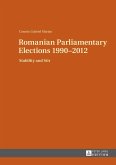- Broschiertes Buch
- Merkliste
- Auf die Merkliste
- Bewerten Bewerten
- Teilen
- Produkt teilen
- Produkterinnerung
- Produkterinnerung
Seit dem Zusammenbruch des Sozialismus unterliegen osteuropäische Gesellschaften einem tiefgreifenden Wandel. Am Beispiel derrumänischen Stadt Timisoara zeigt die Autorin, wie eine lokale Gesellschaft zwischen globaler Öffnung, europäischer Integration und der eigenen kulturellen, habsburgisch- österreichisch geprägten Tradition ihren Weg findet, um sich im postsozialistischen Transformationsprozess politisch und ökonomisch zu behaupten.
Andere Kunden interessierten sich auch für
![Romanian Parliamentary Elections 1990-2012 Romanian Parliamentary Elections 1990-2012]() Cosmin Gabriel MarianRomanian Parliamentary Elections 1990-201242,85 €
Cosmin Gabriel MarianRomanian Parliamentary Elections 1990-201242,85 €![Understanding Post-Communist Transformation Understanding Post-Communist Transformation]() Richard RoseUnderstanding Post-Communist Transformation67,99 €
Richard RoseUnderstanding Post-Communist Transformation67,99 €![Understanding Post-Communist Transformation Understanding Post-Communist Transformation]() Richard RoseUnderstanding Post-Communist Transformation213,99 €
Richard RoseUnderstanding Post-Communist Transformation213,99 €![Creating Silicon Valley in Europe Creating Silicon Valley in Europe]() Steven CasperCreating Silicon Valley in Europe123,99 €
Steven CasperCreating Silicon Valley in Europe123,99 €![Crisis as a Platform for Social Change from Strawberry Mansion to Silicon Valley Crisis as a Platform for Social Change from Strawberry Mansion to Silicon Valley]() Shelton J GoodeCrisis as a Platform for Social Change from Strawberry Mansion to Silicon Valley29,99 €
Shelton J GoodeCrisis as a Platform for Social Change from Strawberry Mansion to Silicon Valley29,99 €![Journal of Romanian Studies Journal of Romanian Studies]() Raluca Coman RaduJournal of Romanian Studies34,00 €
Raluca Coman RaduJournal of Romanian Studies34,00 €![Die Rolle der US-Regierung in der Innovationsleistung des Silicon Valley. Eine Analyse der öffentlichen Sektorbeiträge Die Rolle der US-Regierung in der Innovationsleistung des Silicon Valley. Eine Analyse der öffentlichen Sektorbeiträge]() Umut GünesDie Rolle der US-Regierung in der Innovationsleistung des Silicon Valley. Eine Analyse der öffentlichen Sektorbeiträge18,95 €
Umut GünesDie Rolle der US-Regierung in der Innovationsleistung des Silicon Valley. Eine Analyse der öffentlichen Sektorbeiträge18,95 €-
-
Seit dem Zusammenbruch des Sozialismus unterliegen osteuropäische Gesellschaften einem tiefgreifenden Wandel. Am Beispiel derrumänischen Stadt Timisoara zeigt die Autorin, wie eine lokale Gesellschaft zwischen globaler Öffnung, europäischer Integration und der eigenen kulturellen, habsburgisch- österreichisch geprägten Tradition ihren Weg findet, um sich im postsozialistischen Transformationsprozess politisch und ökonomisch zu behaupten.
Produktdetails
- Produktdetails
- Verlag: Campus Verlag / University of Chicago Press
- Artikelnr. des Verlages: 38126
- Seitenzahl: 194
- Erscheinungstermin: Oktober 2007
- Englisch
- Abmessung: 14mm x 138mm x 212mm
- Gewicht: 258g
- ISBN-13: 9783593381268
- ISBN-10: 3593381265
- Artikelnr.: 20844269
- Herstellerkennzeichnung Die Herstellerinformationen sind derzeit nicht verfügbar.
- Verlag: Campus Verlag / University of Chicago Press
- Artikelnr. des Verlages: 38126
- Seitenzahl: 194
- Erscheinungstermin: Oktober 2007
- Englisch
- Abmessung: 14mm x 138mm x 212mm
- Gewicht: 258g
- ISBN-13: 9783593381268
- ISBN-10: 3593381265
- Artikelnr.: 20844269
- Herstellerkennzeichnung Die Herstellerinformationen sind derzeit nicht verfügbar.
Enikö Baga, Dr. phil., ist wissenschaftliche Mitarbeiterin am Institut für Internationale Beziehungen und Vergleichende Politikwissenschaft an der Universität Frankfurt.
Introduction9Theoretical references13Path-dependency and institutional change13Socialism as an institutional substitute for liberal capitalist modernity14Post-socialist transition as a path-dependent process16Stabilisation of clientelistic regimes20Building alternatives from below22Local-global interconnectedness as an object of investigation23Urban governance24The redefinition of the city26The restructuring of urban government27The specificity of place28The emergence of international production networks30The social creation of meaning33Research methodology35Research objectives and methodological approach35Methodology of the empirical investigation41The Romanian transformation regime44Historical patterns of political and economic development44Pre-socialist development45Development under socialist rule47Social and cultural background49Persistence of familist patterns: "It stinks a bit, but it's warm"49The economy of "getting along"51The "chaotic democracy" and its consequences53The emergence of a party clientelist system53Performance of the democratic institutions60The consequences of economic transformation61"In the land of the blind, the one-eyed man is king": Resources and frameworks determining local action in Timisoara65Material resources: the social and economic profile of Timis County65General overview65Privatisation and property structure67Economic structure and performance70Agriculture72Human capital endowment74The shadow economy and border trade77Conclusions79History and identity: The distinctiveness of the Banat80The historical development of private property, democratic traditions, and regional identity80The legal and institutional frameworks for local action84The general institutional framework of local public administration84The functioning of local government89Opportunities for clientelistic interventions90Administrative corruption and bureaucratic inefficiency92Actors and strategies on the county level94The influence of the central authorities94The role of the county council95Regional development policy under the impact of Europeanization100European Union accession as a general framework for regional development policy100The Development Region West103Cross-border cooperation within the Danube-Kris-Mures-Tisza euroregion107Analytical framework: Networks of opportunity, opportunities for networking109Local strategies and policy models111"The star", "the heart", and the forgotten starlet of the Banat112Types of mayors in Timis County: "The poet", "the administrator" and the "well-connected"116"Progressive", "pragmatic", and "opportunistic": local policy models in Timis County119Strategies of local actors in Timisoara121Organisational "cores" of local policy122Timisoara city hall - organisational structure, tasks and revenues122The CCIAT - organisational structure, tasks and revenues124Institutionalisation patterns on the local level in Timisoara126Timisoara elites: networks of friends and colleagues130History in the discourse of local elites133The specificity of Timisoara within the Romanian context: the relevance of transnational cooperation135Transnational cooperation and institutional innovation136Building institutional capacities: ADETIM - the Economic Development Agency of Timis County137Creating instruments for local development: The Timisoara area local development strategy139Transnational integration of the local economy147Timisoara, nuova provincia veneta148Technological innovation and localised learning157Local actors in technological innovation157Tradition and modernism in the clothing industry163Urban governance in transnational contexts168The privatisation of the drinking water network169The city administration's elderly care project173Limitations and ambivalences of transnational cooperation179The explanatory value of the different theoretical aIntroduction9
Theoretical references13
Path-dependency and institutional change13
Socialism as an institutional substitute for liberal capitalist modernity14
Post-socialist transition as a path-dependent process16
Stabilisation of clientelistic regimes20
Building alternatives from below22
Local-global interconnectedness as an object of investigation23
Urban governance24
The redefinition of the city26
The restructuring of urban government27
The specificity of place28
The emergence of international production networks30
The social creation of meaning33
Research methodology35
Research objectives and methodological approach35
Methodology of the empirical investigation41
The Romanian transformation regime44
Historical patterns of political and economic development44
Pre-socialist development45
Development under socialist rule47
Social and cultural background49
Persistence of familist patterns: "It stinks a bit, but it's warm"49
The economy of "getting along"51
The "chaotic democracy" and its consequences53
The emergence of a party clientelist system53
Performance of the democratic institutions60
The consequences of economic transformation61
"In the land of the blind, the one-eyed man is king": Resources and frameworks determining local action in Timisoara65
Material resources: the social and economic profile of Timis County65
General overview65
Privatisation and property structure67
Economic structure and performance70
Agriculture72
Human capital endowment74
The shadow economy and border trade77
Conclusions79
History and identity: The distinctiveness of the Banat80
The historical development of private property, democratic traditions, and regional identity80
The legal and institutional frameworks for local action84
The general institutional framework of local public administration84
The functioning of local government89
Opportunities for clientelistic interventions90
Administrative corruption and bureaucratic inefficiency92
Actors and strategies on the county level94
The influence of the central authorities94
The role of the county council95
Regional development policy under the impact of Europeanization100
European Union accession as a general framework for regional development policy100
The Development Region West103
Cross-border cooperation within the Danube-Kris-Mures-Tisza euroregion107
Analytical framework: Networks of opportunity, opportunities for networking109
Local strategies and policy models111
"The star", "the heart", and the forgotten starlet of the Banat112
Types of mayors in Timis County: "The poet", "the administrator" and the "well-connected"116
"Progressive", "pragmatic", and "opportunistic": local policy models in Timis County119
Strategies of local actors in Timisoara121
Organisational "cores" of local policy122
Timisoara city hall - organisational structure, tasks and revenues122
The CCIAT - organisational structure, tasks and revenues124
Institutionalisation patterns on the local level in Timisoara126
Timisoara elites: networks of friends and colleagues130
History in the discourse of local elites133
The specificity of Timisoara within the Romanian context: the relevance of transnational cooperation135
Transnational cooperation and institutional innovation136
Building institutional capacities: ADETIM - the Economic Development Agency of Timis County137
Creating instruments for local development: The Timisoara area local development strategy139
Transnational integration of the local economy147
Timisoara, nuova provincia veneta148
Technological innovation and localised learning157
Local actors in technological innovation157
Tradition and modernism in the clothing industry163
Urban governance in transnational contexts168
The privatisation of the drinking water network169
The city administration's elderly care project173
Limitations and ambivalences of transnational cooperation179
The explanatory value of the different theoreti
Theoretical references13
Path-dependency and institutional change13
Socialism as an institutional substitute for liberal capitalist modernity14
Post-socialist transition as a path-dependent process16
Stabilisation of clientelistic regimes20
Building alternatives from below22
Local-global interconnectedness as an object of investigation23
Urban governance24
The redefinition of the city26
The restructuring of urban government27
The specificity of place28
The emergence of international production networks30
The social creation of meaning33
Research methodology35
Research objectives and methodological approach35
Methodology of the empirical investigation41
The Romanian transformation regime44
Historical patterns of political and economic development44
Pre-socialist development45
Development under socialist rule47
Social and cultural background49
Persistence of familist patterns: "It stinks a bit, but it's warm"49
The economy of "getting along"51
The "chaotic democracy" and its consequences53
The emergence of a party clientelist system53
Performance of the democratic institutions60
The consequences of economic transformation61
"In the land of the blind, the one-eyed man is king": Resources and frameworks determining local action in Timisoara65
Material resources: the social and economic profile of Timis County65
General overview65
Privatisation and property structure67
Economic structure and performance70
Agriculture72
Human capital endowment74
The shadow economy and border trade77
Conclusions79
History and identity: The distinctiveness of the Banat80
The historical development of private property, democratic traditions, and regional identity80
The legal and institutional frameworks for local action84
The general institutional framework of local public administration84
The functioning of local government89
Opportunities for clientelistic interventions90
Administrative corruption and bureaucratic inefficiency92
Actors and strategies on the county level94
The influence of the central authorities94
The role of the county council95
Regional development policy under the impact of Europeanization100
European Union accession as a general framework for regional development policy100
The Development Region West103
Cross-border cooperation within the Danube-Kris-Mures-Tisza euroregion107
Analytical framework: Networks of opportunity, opportunities for networking109
Local strategies and policy models111
"The star", "the heart", and the forgotten starlet of the Banat112
Types of mayors in Timis County: "The poet", "the administrator" and the "well-connected"116
"Progressive", "pragmatic", and "opportunistic": local policy models in Timis County119
Strategies of local actors in Timisoara121
Organisational "cores" of local policy122
Timisoara city hall - organisational structure, tasks and revenues122
The CCIAT - organisational structure, tasks and revenues124
Institutionalisation patterns on the local level in Timisoara126
Timisoara elites: networks of friends and colleagues130
History in the discourse of local elites133
The specificity of Timisoara within the Romanian context: the relevance of transnational cooperation135
Transnational cooperation and institutional innovation136
Building institutional capacities: ADETIM - the Economic Development Agency of Timis County137
Creating instruments for local development: The Timisoara area local development strategy139
Transnational integration of the local economy147
Timisoara, nuova provincia veneta148
Technological innovation and localised learning157
Local actors in technological innovation157
Tradition and modernism in the clothing industry163
Urban governance in transnational contexts168
The privatisation of the drinking water network169
The city administration's elderly care project173
Limitations and ambivalences of transnational cooperation179
The explanatory value of the different theoreti
Introduction9Theoretical references13Path-dependency and institutional change13Socialism as an institutional substitute for liberal capitalist modernity14Post-socialist transition as a path-dependent process16Stabilisation of clientelistic regimes20Building alternatives from below22Local-global interconnectedness as an object of investigation23Urban governance24The redefinition of the city26The restructuring of urban government27The specificity of place28The emergence of international production networks30The social creation of meaning33Research methodology35Research objectives and methodological approach35Methodology of the empirical investigation41The Romanian transformation regime44Historical patterns of political and economic development44Pre-socialist development45Development under socialist rule47Social and cultural background49Persistence of familist patterns: "It stinks a bit, but it's warm"49The economy of "getting along"51The "chaotic democracy" and its consequences53The emergence of a party clientelist system53Performance of the democratic institutions60The consequences of economic transformation61"In the land of the blind, the one-eyed man is king": Resources and frameworks determining local action in Timisoara65Material resources: the social and economic profile of Timis County65General overview65Privatisation and property structure67Economic structure and performance70Agriculture72Human capital endowment74The shadow economy and border trade77Conclusions79History and identity: The distinctiveness of the Banat80The historical development of private property, democratic traditions, and regional identity80The legal and institutional frameworks for local action84The general institutional framework of local public administration84The functioning of local government89Opportunities for clientelistic interventions90Administrative corruption and bureaucratic inefficiency92Actors and strategies on the county level94The influence of the central authorities94The role of the county council95Regional development policy under the impact of Europeanization100European Union accession as a general framework for regional development policy100The Development Region West103Cross-border cooperation within the Danube-Kris-Mures-Tisza euroregion107Analytical framework: Networks of opportunity, opportunities for networking109Local strategies and policy models111"The star", "the heart", and the forgotten starlet of the Banat112Types of mayors in Timis County: "The poet", "the administrator" and the "well-connected"116"Progressive", "pragmatic", and "opportunistic": local policy models in Timis County119Strategies of local actors in Timisoara121Organisational "cores" of local policy122Timisoara city hall - organisational structure, tasks and revenues122The CCIAT - organisational structure, tasks and revenues124Institutionalisation patterns on the local level in Timisoara126Timisoara elites: networks of friends and colleagues130History in the discourse of local elites133The specificity of Timisoara within the Romanian context: the relevance of transnational cooperation135Transnational cooperation and institutional innovation136Building institutional capacities: ADETIM - the Economic Development Agency of Timis County137Creating instruments for local development: The Timisoara area local development strategy139Transnational integration of the local economy147Timisoara, nuova provincia veneta148Technological innovation and localised learning157Local actors in technological innovation157Tradition and modernism in the clothing industry163Urban governance in transnational contexts168The privatisation of the drinking water network169The city administration's elderly care project173Limitations and ambivalences of transnational cooperation179The explanatory value of the different theoretical aIntroduction9
Theoretical references13
Path-dependency and institutional change13
Socialism as an institutional substitute for liberal capitalist modernity14
Post-socialist transition as a path-dependent process16
Stabilisation of clientelistic regimes20
Building alternatives from below22
Local-global interconnectedness as an object of investigation23
Urban governance24
The redefinition of the city26
The restructuring of urban government27
The specificity of place28
The emergence of international production networks30
The social creation of meaning33
Research methodology35
Research objectives and methodological approach35
Methodology of the empirical investigation41
The Romanian transformation regime44
Historical patterns of political and economic development44
Pre-socialist development45
Development under socialist rule47
Social and cultural background49
Persistence of familist patterns: "It stinks a bit, but it's warm"49
The economy of "getting along"51
The "chaotic democracy" and its consequences53
The emergence of a party clientelist system53
Performance of the democratic institutions60
The consequences of economic transformation61
"In the land of the blind, the one-eyed man is king": Resources and frameworks determining local action in Timisoara65
Material resources: the social and economic profile of Timis County65
General overview65
Privatisation and property structure67
Economic structure and performance70
Agriculture72
Human capital endowment74
The shadow economy and border trade77
Conclusions79
History and identity: The distinctiveness of the Banat80
The historical development of private property, democratic traditions, and regional identity80
The legal and institutional frameworks for local action84
The general institutional framework of local public administration84
The functioning of local government89
Opportunities for clientelistic interventions90
Administrative corruption and bureaucratic inefficiency92
Actors and strategies on the county level94
The influence of the central authorities94
The role of the county council95
Regional development policy under the impact of Europeanization100
European Union accession as a general framework for regional development policy100
The Development Region West103
Cross-border cooperation within the Danube-Kris-Mures-Tisza euroregion107
Analytical framework: Networks of opportunity, opportunities for networking109
Local strategies and policy models111
"The star", "the heart", and the forgotten starlet of the Banat112
Types of mayors in Timis County: "The poet", "the administrator" and the "well-connected"116
"Progressive", "pragmatic", and "opportunistic": local policy models in Timis County119
Strategies of local actors in Timisoara121
Organisational "cores" of local policy122
Timisoara city hall - organisational structure, tasks and revenues122
The CCIAT - organisational structure, tasks and revenues124
Institutionalisation patterns on the local level in Timisoara126
Timisoara elites: networks of friends and colleagues130
History in the discourse of local elites133
The specificity of Timisoara within the Romanian context: the relevance of transnational cooperation135
Transnational cooperation and institutional innovation136
Building institutional capacities: ADETIM - the Economic Development Agency of Timis County137
Creating instruments for local development: The Timisoara area local development strategy139
Transnational integration of the local economy147
Timisoara, nuova provincia veneta148
Technological innovation and localised learning157
Local actors in technological innovation157
Tradition and modernism in the clothing industry163
Urban governance in transnational contexts168
The privatisation of the drinking water network169
The city administration's elderly care project173
Limitations and ambivalences of transnational cooperation179
The explanatory value of the different theoreti
Theoretical references13
Path-dependency and institutional change13
Socialism as an institutional substitute for liberal capitalist modernity14
Post-socialist transition as a path-dependent process16
Stabilisation of clientelistic regimes20
Building alternatives from below22
Local-global interconnectedness as an object of investigation23
Urban governance24
The redefinition of the city26
The restructuring of urban government27
The specificity of place28
The emergence of international production networks30
The social creation of meaning33
Research methodology35
Research objectives and methodological approach35
Methodology of the empirical investigation41
The Romanian transformation regime44
Historical patterns of political and economic development44
Pre-socialist development45
Development under socialist rule47
Social and cultural background49
Persistence of familist patterns: "It stinks a bit, but it's warm"49
The economy of "getting along"51
The "chaotic democracy" and its consequences53
The emergence of a party clientelist system53
Performance of the democratic institutions60
The consequences of economic transformation61
"In the land of the blind, the one-eyed man is king": Resources and frameworks determining local action in Timisoara65
Material resources: the social and economic profile of Timis County65
General overview65
Privatisation and property structure67
Economic structure and performance70
Agriculture72
Human capital endowment74
The shadow economy and border trade77
Conclusions79
History and identity: The distinctiveness of the Banat80
The historical development of private property, democratic traditions, and regional identity80
The legal and institutional frameworks for local action84
The general institutional framework of local public administration84
The functioning of local government89
Opportunities for clientelistic interventions90
Administrative corruption and bureaucratic inefficiency92
Actors and strategies on the county level94
The influence of the central authorities94
The role of the county council95
Regional development policy under the impact of Europeanization100
European Union accession as a general framework for regional development policy100
The Development Region West103
Cross-border cooperation within the Danube-Kris-Mures-Tisza euroregion107
Analytical framework: Networks of opportunity, opportunities for networking109
Local strategies and policy models111
"The star", "the heart", and the forgotten starlet of the Banat112
Types of mayors in Timis County: "The poet", "the administrator" and the "well-connected"116
"Progressive", "pragmatic", and "opportunistic": local policy models in Timis County119
Strategies of local actors in Timisoara121
Organisational "cores" of local policy122
Timisoara city hall - organisational structure, tasks and revenues122
The CCIAT - organisational structure, tasks and revenues124
Institutionalisation patterns on the local level in Timisoara126
Timisoara elites: networks of friends and colleagues130
History in the discourse of local elites133
The specificity of Timisoara within the Romanian context: the relevance of transnational cooperation135
Transnational cooperation and institutional innovation136
Building institutional capacities: ADETIM - the Economic Development Agency of Timis County137
Creating instruments for local development: The Timisoara area local development strategy139
Transnational integration of the local economy147
Timisoara, nuova provincia veneta148
Technological innovation and localised learning157
Local actors in technological innovation157
Tradition and modernism in the clothing industry163
Urban governance in transnational contexts168
The privatisation of the drinking water network169
The city administration's elderly care project173
Limitations and ambivalences of transnational cooperation179
The explanatory value of the different theoreti








